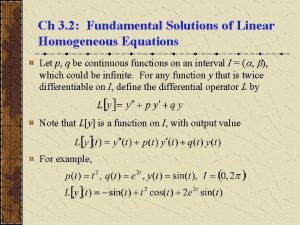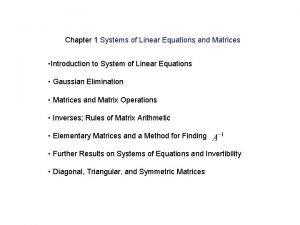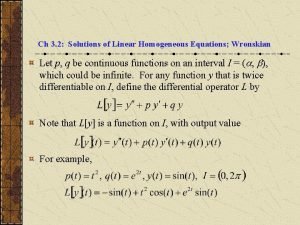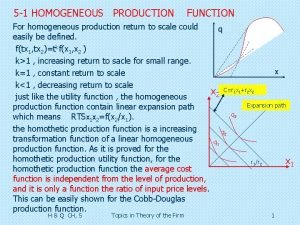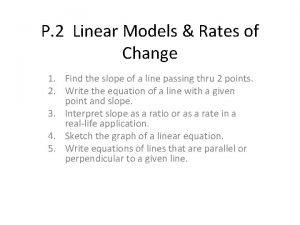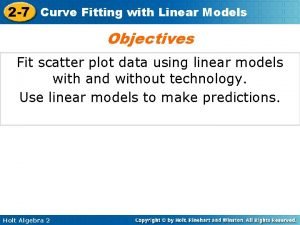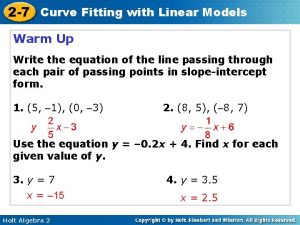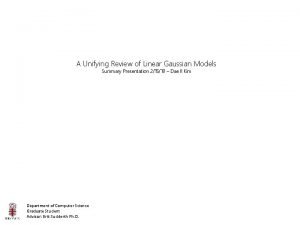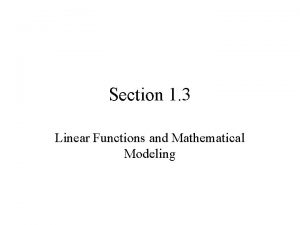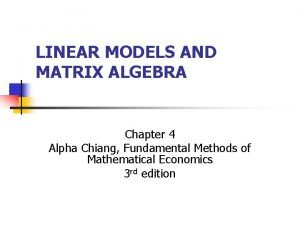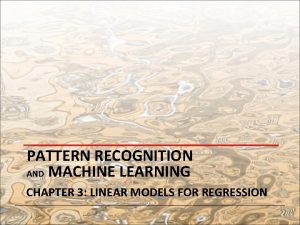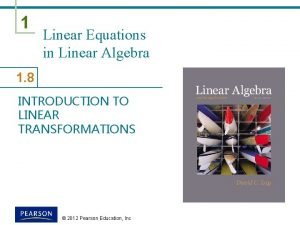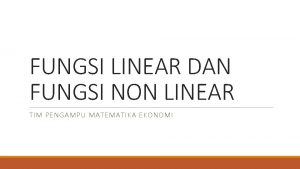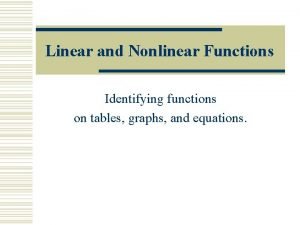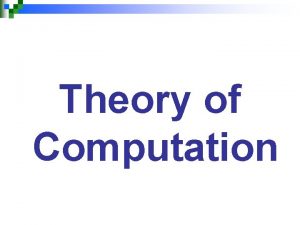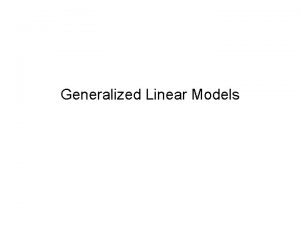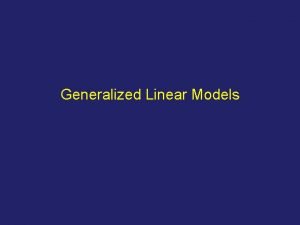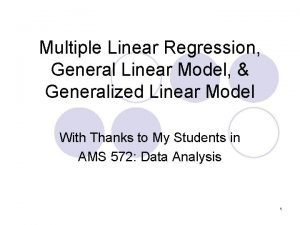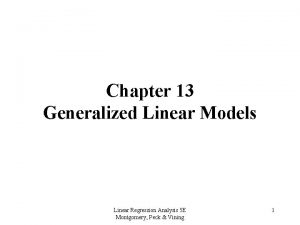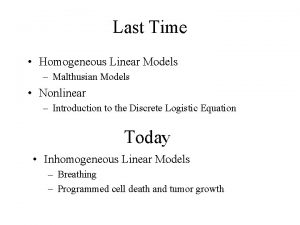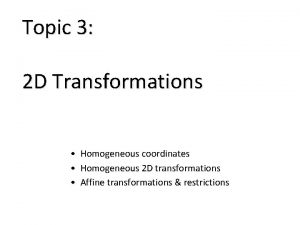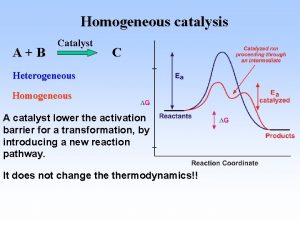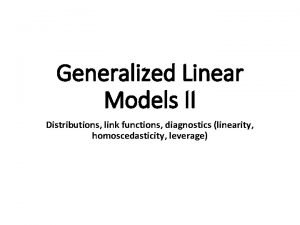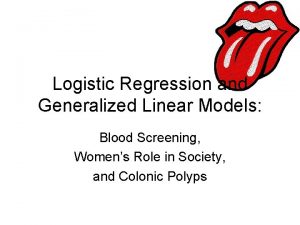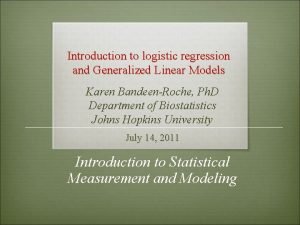10 Generalized linear models 10 1 Homogeneous models












































- Slides: 44

10. Generalized linear models • 10. 1 Homogeneous models – Exponential families of distributions, link functions, likelihood estimation • 10. 2 Example: Tort filings • 10. 3 Marginal models and GEE • 10. 4 Random effects models • 10. 5 Fixed effects models – Maximum likelihood, conditional likelihood, Poisson data • 10. 6 Bayesian Inference • Appendix 10 A Exponential families of distributions

10. 1 Homogeneous models • Section Outline – 10. 1. 1 Exponential families of distributions – 10. 1. 2 Link functions – 10. 1. 3 Likelihood estimation • In this section, we consider only independent responses. – No serial correlation. – No random effects that would induce serial correlation.

Exponential families of distributions • The basic one parameter exponential family is – Here, y is a response and q is the parameter of interest. – The parameter is a scale parameter that we often will assume is known. – The term b(q) depends only on the parameter q, not the responses. – S(y, ) depends only on the responses and the scale parameter, not the parameter q. – The response y may be discrete or continuous. • Some straightforward calculations show that E y = b (q) and Var y = b (q) .

Special cases of the basic exponential family • Normal – The probability density function is – Take m = q, s 2 = f , b(q) = q 2/2 and S(y, ) = - y 2 / (2 ) - ln(2 p ))/2. – Note that E y = b (q) = q = m and Var y = b (m) s 2 = s 2. • Binomial, n trials and prob p of success – The probability mass function is – Take ln (p/(1 -p))= logit (p) = q, 1 = f , b(q) = n ln (1 + eq) and S(y, ) = ln((n choose y)). – Note that E y = b (q) = n eq/(1 + eq) = n p and Var y = b (q) (1) = n eq/(1 + eq)2 = n p(1 -p) , as anticipated.

Another special case of the basic exponential family • Poisson – The probability mass function is – Take ln (l) = q, 1 = f , b(q) = eq and S(y, ) = -ln( y!)). – Note that E y = b (q) = eq = l and – Var y = b (q) (1) = eq = l , as anticipated.


10. 1. 2 Link functions • To link up the univariate exponential family with regression problems, we define the systematic component of yit to be hit = xit b. • The idea is to now choose a “link” between the systematic component and the mean of yit , say mit , of the form: hit = g(mit). – g(. ) is the link function. • Linear combinations of explanatory variables, hit = xit b, may vary between negative and positive infinity. – However, means may be restricted to smaller range. For example, Poisson means vary between zero and infinity. – The link function serves to map the domain of the mean function onto the whole real line.

Bernoulli illustration of links • Bernoulli means vary between 0 and 1, although linear combinations of explanatory variables may vary between negative and positive infinity. • Here are three important examples of link functions for the Bernoulli distribution: – Logit: h = g(m) = logit(m) = ln (m/(1 - m)). – Probit: h = g(m) = F-1(m) , where F-1 is the inverse of the standard normal distribution function. – Complementary log-log: h = g(m) = ln ( -ln(1 - m) ). • Each function maps the unit interval (0, 1) onto the whole real line.

Canonical links • As we have seen with the Bernoulli, there are several link functions that may be suitable for a particular distribution. • When the systematic component equals the parameter of interest (h = q ), this is an intuitively appealing case. – That is, the parameter of interest, q , equals a linear combination of explanatory variables, h. – Recall that h = g(m) and m = b (q). – Thus, if g-1 = b , then h = g(b (q)) = q. – The choice of g, such that g-1 = b , is called a canonical link. • Examples: Normal: g(q) = q, Binomial: g(q) = logit(q), Poisson: g(q) = ln q.

10. 1. 3 Estimation • Begin with likelihood estimation for canonical links • Consider responses yit, with mean mit, systematic component hit = g(mit) = xit b and canonical link so that hit = qit. – Assume the responses are independent. • Then, the log-likelihood is

MLEs - Canonical links • The log-likelihood is • Taking the partial derivative with respect to b yields the score equations: – because mit = b (qit) = b (xit b ). • Thus, we can solve for the mle’s of b through: 0 = Sit xit (yit - mit). – This is a special case of the method of moments.

MLEs - general links • For general links, we no longer assume the relation qit = xit b. • We assume that b is related to qit through mit = b (qit) and hit = xit b = g(mit). • Recall that the log-likelihood is – Further, E yit = mit and Var yit = b (qit) / . • The jth element of the score function is – because b (qit) = mit

MLEs - more on general links • To eliminate qit, we use the chain rule to get • Thus, • This yields • This is called the generalized estimating equations form.

Overdispersion • When fitting models to data with binary or count dependent variables, it is common to observe that the variance exceeds that anticipated by the fit of the mean parameters. – This phenomenon is known as overdispersion. – A probabilistic models may be available to explain this phenomenon. • In many situations, analysts are content to postulate an approximate model through the relation Var yit = 2 b (xit β) / wit. – The scale parameter is specified through the choice of the distribution – The scale parameter σ2 allows for extra variability. • When the additional scale parameter σ2 is included, it is customary to estimate it by Pearson’s chi-square statistic divided by the error degrees of freedom. That is,

10. 2 Example: Tort filings


Offsets • We assume that yit is Poisson distribution with parameter POPit exp(xit β), – where POPit is the population of the ith state at time t. • In GLM terminology, a variable with a known coefficient equal to 1 is known as an offset. • Using logarithmic population, our Poisson parameter for yit is • An alternative approach is to use the average number of tort filings as the response and assume approximate normality. – Note that in the Poisson model above the expectation of the average response is – whereas the variance is

Tort filings • Purpose: to understand ways in which state legal, economic and demographic characteristics affect the number of filings. • Table 10. 3 suggests more filings under JSLIAB and PUNITIVE but less under CAPS • Table 10. 5 – All variables under the homogenous model are statistically significant – However, estimated scale parameter seems important • Here, only JSLIAB is (positively) statistically significant – Time (categorical) variable seems important


10. 3 Marginal models • This approach reduces the reliance on the distributional assumptions by focusing on the first two moments. • We first assume that the variance is a known function of the mean up to a scale parameter, that is, Var yit = v(mit) . – This is a consequence of the exponential family, although now it is a basic assumption. – That is, in the GLM setting, we have Var yit = b (qit) and mit = b (qit). – Because b(. ) and f are assumed known, Var yit is a known function of mit. • We also assume that the correlation between two observations within the same subject is a known function of their means, up to a vector of parameters t. – That is corr(yir , yis ) = r(mir , mis , t) , for r(. ) known.

Marginal model • This framework incorporates the linear model nicely; we simply use a GLM with a normal distribution. – However, for nonlinear situations, a correlation is not always the best way to capture dependencies among observations. • Here is some notation to help see the estimation procedures. • Define mi = (mi 1, mi 2, . . . , mi. Ti)´ to be the vector of means for the ith subject. • To express the variance-covariance matrix, we – define a diagonal matrix of variances Vi = diag(v(mi 1), . . . , v( mi. Ti) ) – and the matrix of correlations Ri(t) to be a matrix with r(mir , mis , t) in the rth row and sth column. – Thus, Var yi = Vi 1/2 Ri(t) Vi 1/2.

Generalized estimating equations • These assumptions are suitable for a method of moments estimation procedure called “generalized estimating equations” (GEE) in biostatistics, also known as the generalized method of moments (GMM) in econometrics. • GEE with known correlation parameter – Assuming t is known, the jth row of the GEE is – Here, the matrix – is Ti x K*. • For linear models with mit = zit ai + xit b , this is the GLS estimator introduced in Section 3. 3.

Consistency of GEEs • The solution, b. EE, is asymptotically normal with covariance matrix – Because this is a function of the means, mi, it can be consistently estimated.

Robust estimation of standard errors • empirical standard errors may be calculated using the following estimator of the asymptotic variance of b. EE

GEE - correlation parameter estimation • For GEEs with unknown correlation parameters, Prentice (1988) suggests using a second estimating equation of the form: – where – Diggle, Liang and Zeger (1994) suggest using the identity matrix for most discrete data. • However, for binary responses, – they note that the last Ti observations are redundant because yit = yit 2 and should be ignored. – they recommend using

Tort filings • Assume an independent working correlation – This yields at the same parameter estimators as in Table 10. 5, under the homogenous Poisson model with an estimated scale parameter. – JSLIAB is (positively) statistically significant, using both model-based and robust standard errors. • To test the robustness of this model fit, we fit the same model with an AR (1) working correlation. – Again, JSLIAB is (positively) statistically significant. – Interesting that CAPS is now borderline but in the opposite direction suggested by Table 10. 3


10. 4 Random effects models • The motivation and sampling issues regarding random effects were introduced in Chapter 3. • The model is easiest to introduce and interpret in the following hierarchical fashion: – 1. Subject effects {ai} are a random sample from a distribution that is known up to a vector of parameters t. – 2. Conditional on {ai}, the responses – {yi 1, yi 2, . . . , yi. Ti } are a random sample from a GLM with systematic component hit = zit ai + xit b.

Random effects models • This model is a generalization of: – 1. The linear random effects model in Chapter 3 - use a normal distribution. – 2. The binary dependent variables random effects model of Section 9. 2 - using a Bernoulli distribution. (In Section 9. 2, we focused on the case zit =1. ) • Because we are sampling from a known distribution with a finite/small number of parameters, the maximum likelihood method of estimation is readily available. • We will use this method, assuming normally distributed random effects. • Also available in the literature is the EM (for expectationmaximization) algorithm for estimation - See Diggle, Liang and Zeger (1994).

Random effects likelihood • Conditional on ai, the likelihood for the ith subject at the tth observation is • where b (qit) = E (yit | ai) and hit = zit ai + xit b = g(E (yit | ai) ). • Conditional on ai, the likelihood for the ith subject is: • We take expectations over ai to get the (unconditional) likelihood. • To see this explicitly, let’s use the canonical link so that qit = hit. The (unconditional) likelihood for the ith subject is • Hence, the total log-likelihood is Si ln li. – The constant Sit. S(yit , ) is unimportant for determining mle’s. – Although evaluating, and maximizing, the likelihood requires numerical integration, it is easy to do on the computer.

Random effects and serial correlation • We saw in Chapter 3 that permitting subject-specific effects, ai, to be random induced serial correlation in the responses yit. – This is because the variance-covariance matrix of yit is no longer diagonal. • This is also true for the nonlinear GLM models. To see this, – let’s use a canonical link and – recall that E (yit | ai) ) = b (qit) = b (hit ) = b (ai + xit b).

Covariance calculations • The covariance between two responses, yi 1 and yi 2 , is Cov(yi 1 , yi 2 ) = E yi 1 yi 2 - E yi 1 E yi 2 = E {b (ai+xi 1 b) b (ai+xi 2 b)} - E b (ai+xi 1 b) E b (ai+xi 2 b) • To see this, using the law of iterated expectations, E yi 1 yi 2 = E E (yi 1 yi 2 | ai) = E {E (yi 1| ai) E(yi 2 | ai)} = E {b (ai + xi 1 b) b (ai + xi 2 b)}

More covariance calculations • Normality • For the normal distribution we have b (a) = a. • Thus, Cov(yi 1 , yi 2 ) = E {(ai + xi 1 b) (ai + xi 2 b)} - E (ai + xi 1 b) E (ai + xi 2 b) = E ai 2 + (xi 1 b) (xi 2 b) - (xi 1 b) (xi 2 b) = Var ai. • For the Poisson, we have b (a) = ea. Thus, E yit = E b (ai+ xit b) = E exp(ai+ xit b) = exp(xit b) E exp(ai) and • Cov(yi 1 , yi 2 ) = E {exp(ai+ xi 1 b) exp(ai+ xi 2 b)} - exp((xi 1+xi 2) b) {E exp(ai)}2 = exp((xi 1+xi 2) b) {E exp(2 a) - (E exp(a))2 } = exp((xi 1+xi 2) b) Var exp(a).

Random effects likelihood • Recall, from Section 10. 2, that the (unconditional) likelihood for the ith subject is • Here, we use zit = 1, and g(a) is the density of ai. • For the Poisson, we have b(a) = ea , and S(y, ) = -ln(y!), so the likelihood is • As before, evaluating and maximizing the likelihood requires numerical integration, yet it is easy to do on the computer.


10. 5 Fixed effects models • Consider responses yit, with mean mit, systematic component hit = g(mit) = zit ai + xit b and canonical link so that hit = qit. – Assume the responses are independent. • Then, the log-likelihood is • Thus, the responses yit depend on the parameters through only summary statistics. – That is, the statistics St yit zit are sufficient for ai. – The statistics Sit yit xit are sufficient for b. – This is a convenient property of the canonical links. It is not available for other choices of links.

MLEs - Canonical links • The log-likelihood is • Taking the partial derivative with respect to ai yields: – because mit = b (qit) = b (zit ai + xit b ). • Taking the partial derivative with respect to b yields: • Thus, we can solve for the mle’s of ai and b through: 0 = St zit (yit - mit), and 0 = Sit xit (yit - mit). – This is a special case of the method of moments. – This may produce inconsistent estimates of b , as we have seen in Chapter 9.


Conditional likelihood estimation • Assume the canonical link so that qit = hit = zit ai + xit b. • Define the likelihood for a single observation to be • Let Si be the random vector representing St zit yit and let sumi be the realization of St zit yit. – Recall that St zit yit are sufficient for ai. • The conditional likelihood of the data set is – This likelihood does not depend on {ai}, only on b. – Maximizing it with respect to b yields root-n consistent estimates. • The distribution of Si is messy and is difficult to compute.

Poisson distribution • The Poisson is the most widely used distribution for counted responses. – Examples include the number of migrants from state to state and the number of tort filings within a state. • A feature of the fixed effects version of the model is that the mean equals the variance. • To illustrate the application of Poisson panel data models, let’s use the canonical link and zit = 1, so that ln E (yit | ai) = g(E (yit | ai) ) = qit = hit = ai + xit b. • Through the log function, it links the mean to a linear combination of explanatory variables. It is the basis of the so-called “log-linear” model.

Conditional likelihood estimation • We first examine the fixed effects model and thus assume that {ai} are fixed parameters. – Thus, E yit = exp (ai + xit b). – The distribution is – From Section 10. 1, St yit is a sufficient statistic for ai. • The distribution of St yit turns out to be Poisson, with mean exp(ai) St exp(xit b). • Note that the ratio of means, – does not depend on ai.

Conditional likelihood details • Thus, as in Section 10. 1, the conditional likelihood for the ith subject is

Conditional likelihood details – where – This is a multinomial distribution.

Multinomial distribution • Thus, the joint distribution of yi 1, . . . , yi. Ti given St yit has a multinomial distribution. • The conditional likelihood is: • Taking partial derivatives yields: – where –. • Thus, the conditional MLE, b, is the solution of:
 Application of homogeneous differential equation
Application of homogeneous differential equation Linear phase system
Linear phase system Sas generalized linear model
Sas generalized linear model Fundamental solutions of linear homogeneous equations
Fundamental solutions of linear homogeneous equations Homogeneous system of linear equations examples
Homogeneous system of linear equations examples Fundamental solutions of linear homogeneous equations
Fundamental solutions of linear homogeneous equations Linear homogeneous recurrence relation
Linear homogeneous recurrence relation Linear homogeneous production function
Linear homogeneous production function Semi modal verbs
Semi modal verbs Linear models and rates of change
Linear models and rates of change Linear programming models graphical and computer methods
Linear programming models graphical and computer methods Linear functions as mathematical models
Linear functions as mathematical models Linear communication example
Linear communication example Curve fitting with linear models
Curve fitting with linear models Linear communication and interactive model
Linear communication and interactive model Curve fitting with linear models
Curve fitting with linear models A unifying review of linear gaussian models
A unifying review of linear gaussian models Linear functions as mathematical models
Linear functions as mathematical models Four models of curriculum development
Four models of curriculum development Matrix algebra
Matrix algebra Linear basis function models
Linear basis function models Linear vs quadratic vs exponential
Linear vs quadratic vs exponential Linear editing vs non linear editing
Linear editing vs non linear editing Linear algebra 1
Linear algebra 1 Contoh soal persamaan non linier
Contoh soal persamaan non linier How to identify linear functions from tables
How to identify linear functions from tables Fungsi linear dan non linear
Fungsi linear dan non linear Pipeline is a linear.
Pipeline is a linear. Eliminasi gauss naif
Eliminasi gauss naif Titik penggal adalah
Titik penggal adalah Types of linear text
Types of linear text Linear or nonlinear tables
Linear or nonlinear tables Sebutkan dan jelaskan contoh fungsi non linear
Sebutkan dan jelaskan contoh fungsi non linear What is nonlinear multimedia
What is nonlinear multimedia Right linear grammar to left linear grammar
Right linear grammar to left linear grammar Principle of linear impulse and momentum
Principle of linear impulse and momentum Nonlinear plot structure
Nonlinear plot structure Difference between linear and nonlinear
Difference between linear and nonlinear Do linear transformations preserve linear independence
Do linear transformations preserve linear independence Convert right linear grammar to left linear grammar
Convert right linear grammar to left linear grammar Simple linear regression and multiple linear regression
Simple linear regression and multiple linear regression Narrador protagonista
Narrador protagonista Persamaan linier simultan
Persamaan linier simultan Sistem persamaan non linier metode numerik
Sistem persamaan non linier metode numerik Transition graph examples
Transition graph examples



